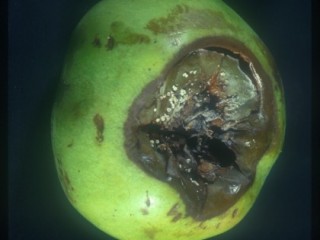
See also Neonectria canker
Neonectria rot occurs both in the orchard and in store and in favourable seasons losses in store can be as high as 30%, particularly on Bramley where the fruit is stored for almost 12 months.
The disease life cycle and epidemiology involves fruit infection occuring on the tree through the calyx, lenticel or stalk end and takes place between blossom and harvest.
The disease causes a fruit rot with characteristic symptoms in the eye, at the stalk end or on the cheek.
- The rots are soft, slightly sunken, with the rotted part easily scooped out from the sound flesh.
- Eye rots are visible in the orchard from early summer as well as in store. They are usually brown in colour with white/creamy cobwebby sporing pustules visible on mature rots.
- Cheek and stalk-end rots only appear in store and are circular, brown with pale brown centres.

Neonectria rot at stalk end
Neonectria rots appear in cold-stored fruit from late December onwards and increase in incidence the longer the fruit is stored.
- The rot colour depends on variety and storage conditions.
- Rots on fruit stored in low oxygen tend to be green in coour with very little sporulation, whereas those in higher oxygen storage tend to be brown with white/creamy sporing pustules.
Disease monitoring, forecasting and rot risk assessment are important for minimising losses.
- Orchards at risk from Neonectria rot can be identified in spring based on the incidence of cankered trees in the orchard (<5% = low risk, 5-25% = moderate risk, >25% = high risk) and the rot history from pack house records.
- The risk of Neonectria rot in store can then be further assessed based on the rainfall between blossom and harvest.
Control
Effective control of Neonectria requires an integrated approach with both cultural and chemical treatments.
- Apply sprays of captan or pyraclostrobin + boscalid (Bellis) or cyprodinil + fludioxonil (Switch) to orchards where a risk has been identified during blossom and at petal fall.
- These will give fruit some protection against Neonectria rot and in orchards with a high canker incidence are essential if fruit is to be stored without significant losses beyond Christmas.
- The same treatments can be applied pre-harvest in late July and August.
- In orchards where a high canker risk has been identified, the best option may be to avoid chemical treatment and schedule the fruit for early marketing before Christmas to minimise losses.
- The Neonectria risk of fruit from lower risk orchards is based on the amount of rainfall blossom-harvest.
- In seasons when rainfall is above average this fruit may also need to be scheduled for early marketing if sprays at blossom and petal fall were not applied.
Control in organic orchards
- Cultural methods of control are most important.
- Copper fungicides are permitted in organic production at present and should be applied at autumn leaf fall and pre-bud burst in orchards at risk from Neonectria canker.
- Use rot risk assessment to determine the risk of rotting in store, likely losses in store and hence storage potential.
